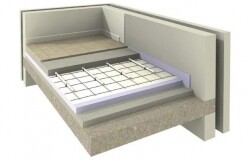There are specific reasons for having underfloor heating installed in your home. Not only do you have the comfort of warm feet, but also of even heat distribution and a lower energy bill. Not sure what type of underfloor heating to choose. One of the options is the so-called dry system. We will tell you everything you need to know.
How does a dry system work?
A 'dry' insulation system does not mean that no water is involved. This name only refers to the installation: with a dry system, the pipes do not come into direct contact with the wet cement top floor or screed. Instead, the pipes lie in preformed insulation sheets of polystyrene foam or polystyrene. These insulation sheets act as a heat conductor and ensure that the heating up time is shorter than with a wet system and that the heat distribution is even better. Aluminium or metal gutters are placed in the insulation sheets, into which the heating pipes are placed. A sheet of the same material is put on top of the gutters. These metals also contribute to faster heat distribution and dissipation. It is therefore no surprise that more and more people are opting for this new type of floor heating.
Ideal for renovations
Underfloor hearing with a dry system is the perfect choice when renovating, since the installation height of this system is just 6 cm. That means a dry system is ideal for renovation houses with a low installation height. In addition, a dry system is also particularly suitable for new houses with a timber frame.
Which floors can you combine with it?
Good news: you can combine a dry system with different floor-types. Whether you prefer ceramic tiles, natural stone or even parquet: the possibilities are endless!
